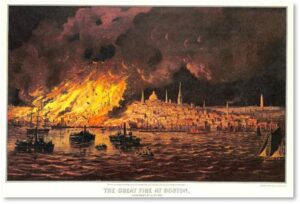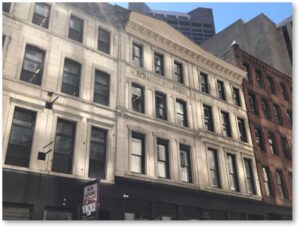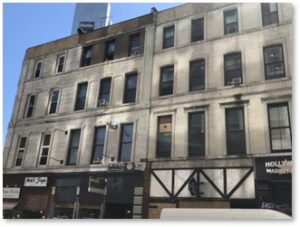In the Before Time, I would occasionally drive into Boston and just wander around, taking pictures of buildings that grabbed my attention. I usually found a lot of places, both big and small, tall and short, that stopped and demanded that I pay attention.
Many of Boston’s structures have significant history attached to them. Some, like the old Museum of Natural History, attract with their beauty. Others, like the Chadwick Lead Works, stand out amid their surroundings. Quite a few of the 18th-century granite structures, like the International Trust Building, display beautiful decorations and carvings.
The Richardson Block offers none of these attractions.
Built for Business
The Richardson Block, a group of nine attached buildings at 113 – 151 Pearl Street and 109 – 119 High Street was built for business. Jeffrey Richardson constructed the block in 1873 after the Great Fire of the previous year. William G. Preston designed the first group of buildings, at the corner of Pearl and High Street to be a single unified block in the Neo-Greek style. The Richardson Block’s buildings have been described as the “only neo-Greek commercial structures standing in the Financial District.”
The block was built in three stages over 12 years, a common pattern of ownership and construction in Boston’s Central Business District. Mr. Preston conceived the block’s buildings as a single design unit, which individual owners took responsibility for construction on their respective parcels.
Rising from the Ashes
The Richardson Block literally rose from the ashes and, Phoenix-like, reconstituted itself from the rubble.
 Seven of the nine buildings were constructed in 1873 according to Mr. Preston’s scheme. He used granite and brick salvaged from the 1856 granite warehouse, owned by the sons of Jeffrey Richardson, that had previously occupied the site.
Seven of the nine buildings were constructed in 1873 according to Mr. Preston’s scheme. He used granite and brick salvaged from the 1856 granite warehouse, owned by the sons of Jeffrey Richardson, that had previously occupied the site.
Boston’s thrifty builders have often repurposed building materials but one can’t help wondering if these recycled stones were still warm from the massive conflagration that demolished most of what is now the city’s Financial District.
An eighth building at 123 Pearl Street was completed in 1876 according to Preston’s design. Not until 1885 did the block reach completion when the final building at 115 Pearl Street was built to the plans of another architect.
The Richard’s Block’s Design
With the exception of one building that acquired a glass-fronted penthouse addition, the buildings in the Richardson Block designed by Mr. Preston are four stories high. They have flat roofs, white marble façades, and side and rear walls of brick. The Richardson Block displays a 5-9-3-9-5 rhythm of bays along Pearl Street by incorporating a beveled corner at the High Street (north) end, and a rounded corner at the Purchase Street (south) end.
Corner quoins on the first and second floors define the five-bay end pavilions. Paneled piers top the quoins on the third and fourth floors. The centermost building in the block at 129 Pearl Street presents as the frontispiece, with its three-bay façade projecting slightly. Pilasters set it off, topped by a metal, modillion block cornice with a triangular pediment.
A marble panel above the third-floor windows of the frontispiece reads RICHARDSON BLOCK in block letters carved in relief.
The regular window pattern, with its continuous marble sill courses on each floor, unify the Richardson Block’s buildings. Window surrounds display incised floral ornament. A hierarchy of lintel shapes places shaped and flat triangular lintels on the second floor, segmental-arched lintels on the third floor, and rectangular lintels on the fourth floor.
Quiet and Unlovely
For all that consistency and detail, these are not lovely buildings. The Richardson Block will not stop you in your tracks by shouting “Hey, I’m gorgeous. Look at me!” Instead, it does its best to disappear.
Undistinguished storefronts line the street level, obscure the building above. Most storefronts retain the cast-iron columns and granite lintels they had in 1986, when the Richardson Block was first listed in the National Register of History Landmarks. “Modern” signage and veneer panels obscure some original details. They also give the block’s street front a commonplace, if not upscale, look.
When you do look up, you find the marble has weathered to an appropriate ash-gray. Some of it has gone missing at the parapet level. At least one window has been blocked with plywood.
In the Gridley Street Historic District
The Richardson Block may be historical and architecturally significant but it does not shine. It does, however, belong to a small island of low-level buildings amid the glass-and-metal curtain walls of the office towers around it: the Gridley Street Historic District.
This area of Boston served as a focus of the leather industry both before and after the fire. Several occupants of the Richardson Block were in the leather trade, while novelties and patent medicines were also sold there. Firms such as the Chicago Varnish Co., a dealer in carriage varnishes, and hollow-ware dealers Hill Whitney & Co. and Leavitt & Co. also occupied the Richardson Block.
If you go to see the Richardson Block, know what you are looking for and where it is. The buildings may be unassuming but they are very much present and holding on amid the towering structures around them.





